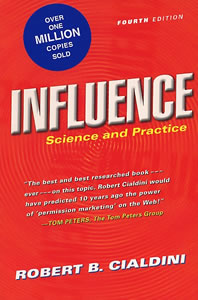 Robert Cialdini’s book is all about “click, whirr” – how we’re programmed as humans, how marketing can leverage the programming, and how as individuals we can overcome the programming. The six major influence techniques that he explains are:
Robert Cialdini’s book is all about “click, whirr” – how we’re programmed as humans, how marketing can leverage the programming, and how as individuals we can overcome the programming. The six major influence techniques that he explains are:
1. Reciprocation: We feel indebted to people who gives us something of value. For example, when someone gives us a sample of a product to taste, we often feel that we need to stop and converse with the attendant. Salespeople know that giving something of small value can trigger higher value purchases to alleviate the imbalance (“I owe you”). A sophisticated version of this is to make a large request of a prospective buyer, with the intention of having the request be rejected. The real goal is the second “fall-back” request, which seems reasonable in contrast.
2. Commitment and Consistency: Once we make a decision (or promise), our subsequent actions maintain the sense of commitment. We don’t want to appear to be wishy-washy. We also don’t want to have to rethink the decision each time – better to be consistently wrong than overwhelmed with research. Salespeople’s goal is to get you to commit to a belief, then create arguments why you should then purchase from them based on your belief system. This psychological one-two punch is used in everything from testimonials (by going on the record, you have a vested interest in being consistent) to hazing rituals.
3. Social Proof: As social beings, we 0ften feel that the more people that like (or do) something, the better it is (whether this be a fad or canned laughter). We tend to trust the pack mentality because we’re busy (if others pre-chose, then we don’t have to think — it must be good) and we’re trusting (other people that are smarter, better-looking, etc. chose it so we’re better off being part of the “in” group than not).
4. Liking: We all want to be liked, so when a salesperson likes you (even if you know they’re just saying it), some part of us feels good. If the salesperson is well-dressed, well-groomed, and similar to us (in mannerisms) we want to believe them (all things being equal) and want to be liked by them.
5. Authority: We’re not just social beings, but we’re naturally hierarchical. We’re used to following an authority figure (who a group of people have endowed with special trustworthy qualities). A person who looks like they’re in authority (by dress, mannerisms, professional title, social standing, etc.) we naturally follow the advice of (even if they are advising something they’re not the authorities of).
6. Scarcity: This is tied to social proof – if there’s not a lot of something (whether real or imagined), then it’s perceived value is higher (we have a fear of missing out on the opportunity). This is also true in the converse – if you ban something, you increase its desirability.